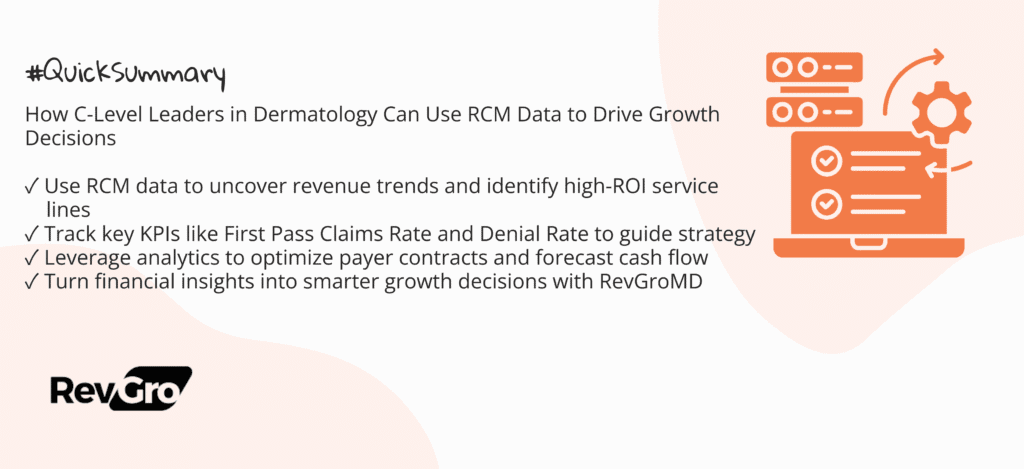
- Why RCM Data is the New Strategic Currency
- Aligning Financial KPIs with Business Growth Goals
- Using RCM Insights to Guide Service Line Expansion
- Leveraging RCM Data to Optimize Payer Relationships
- Improving Patient Payment Strategies with Data
- Forecasting and Strategic Planning with RCM Analyticss
- The Executive Advantage: Turning RCM Data into Strategic Action
- Conclusion: From Numbers to Growth Strategy

In dermatology practices, success today is defined by more than patient satisfaction and clinical excellence — it’s driven by data. Specifically, Revenue Cycle Management (RCM) data has become a goldmine for C-level leaders looking to scale operations, improve profitability, and make smarter strategic decisions.
In a landscape where payer complexities, patient payment trends, and operational inefficiencies directly affect margins, leveraging RCM data as a decision-making tool gives dermatology executives a competitive edge.
This blog explores how C-level leaders in dermatology — CEOs, CFOs, and Practice Administrators — can turn RCM insights into actionable growth strategies.
Why RCM Data is the New Strategic Currency
Revenue Cycle Management isn’t just a billing process — it’s an intelligence system that captures every financial touchpoint of the patient journey.
From eligibility verification and charge capture to claims denial patterns and payer reimbursements, RCM data reveals where revenue is gained, lost, or delayed.
For dermatology executives, this data helps answer strategic questions like:
Which service lines are the most profitable?
Are we losing revenue to payer denials or undercoding?
How efficiently is cash being collected compared to benchmarks?
By treating RCM as a strategic growth pillar rather than a back-office function, leaders can align financial and operational goals to improve long-term scalability.
C-level leaders should focus on RCM metrics that directly correlate to profitability and scalability. The key is aligning clinical productivity with financial outcomes.
Essential KPIs Dermatology Leaders Should Monitor
First Pass Claims Rate (FPCR): A strong indicator of operational efficiency; aim for 95%+.
Days in Accounts Receivable (AR): Reflects how quickly payments are collected; best-in-class practices stay under 30 days.
Denial Rate: Should remain below 5%; higher rates indicate workflow or payer contracting issues.
Net Collection Rate (NCR): Measures how much of the allowed amount is actually collected; target above 95%.
Patient Collection Ratio: Increasingly important in dermatology due to rising out-of-pocket costs.
Tracking these KPIs over time helps leadership identify trends, forecast revenue, and make informed decisions about investments in technology, staffing, or new service lines.
Using RCM Insights to Guide Service Line Expansion
Dermatology practices often diversify into cosmetic, surgical, and medical dermatology to broaden revenue streams. RCM data can guide which areas offer the highest ROI.
For example:
Analyzing payer reimbursements can reveal low-margin procedures that are consuming high operational costs.
Tracking visit volumes and CPT utilization rates can identify underserved services worth expanding.
Patient payment data may highlight growing demand for cash-based cosmetic treatments, supporting the case for self-pay service lines.
By connecting clinical trends with financial data, leaders can confidently allocate resources and expand strategically rather than reactively.
Leveraging RCM Data to Optimize Payer Relationships
For most dermatology practices, payer contracts define profitability. Yet many leaders rely on outdated or anecdotal performance insights during contract renewals.
RCM analytics can quantify:
Reimbursement variance between payers for the same procedures.
Claim denial patterns linked to specific payers or codes.
Payment delays that affect cash flow stability.
By using this data in negotiations, leaders can renegotiate rates, push for faster reimbursement cycles, and prioritize contracts that drive the most value.
Example:
If data shows that one major insurer consistently delays payments beyond 45 days or reimburses below the regional average for dermatopathology services, executives can approach renegotiations armed with factual leverage.
Improving Patient Payment Strategies with Data
With out-of-pocket expenses rising, dermatology practices must adapt their patient billing strategies. RCM data reveals patterns that help leadership enhance patient collections without damaging satisfaction.
Actionable Insights Include:
Tracking which services have the highest patient balance write-offs.
Identifying demographics or locations with delayed payments.
Using predictive analytics to determine the likelihood of patient default.
Armed with this information, leaders can implement:
Upfront cost transparency tools at check-in.
Automated payment reminders and digital payment options.
Customized financial counseling programs for high-cost procedures.
This not only boosts cash flow but also improves the patient financial experience — an increasingly important differentiator in dermatology.
Forecasting and Strategic Planning with RCM Analytics
Modern RCM platforms provide real-time dashboards that allow leaders to forecast revenue and plan strategically.
For C-level executives, the ability to visualize:
Future cash inflows,
Seasonal fluctuations in patient visits, and
Payer-specific performance
enables smarter staffing, marketing, and investment decisions.
For example, identifying seasonal dips in medical dermatology visits can help redirect marketing spend toward cosmetic treatments during slower months — balancing revenue streams year-round.
The Executive Advantage: Turning RCM Data into Strategic Action
RCM data is only valuable when transformed into insight-driven action. For dermatology leadership, that means creating a data-to-decision pipeline.
Key Leadership Moves:
Integrate RCM Dashboards into Board Reviews: Make RCM performance part of quarterly strategy meetings.
Collaborate Across Departments: Encourage clinical, operational, and financial leaders to act on shared metrics.
Invest in Predictive Analytics: Move from historical reporting to forecasting future payer and patient trends.
Outsource Strategically: Partner with expert RCM firms that provide not just billing support, but analytical intelligence and consultative insights.
With data visibility and accountability in place, executives can drive measurable growth, not just incremental revenue recovery.
Conclusion: From Numbers to Growth Strategy
For C-level leaders in dermatology, RCM data is no longer a back-office metric — it’s a boardroom asset. The insights hidden in your claims, collections, and payment patterns can reveal where to expand, when to negotiate, and how to improve efficiency.
By using data-driven RCM strategies, dermatology executives can:
Boost profit margins,
Strengthen payer relationships,
Improve operational predictability, and
Accelerate long-term practice growth.
At RevGroMD, we help dermatology practices leverage RCM intelligence to make confident, data-backed business decisions.
Partner with RevGroMD to unlock the full potential of your RCM data and turn insights into strategic growth.
